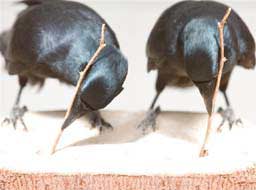Crows have side biases just like humans
Across the world, the vast majority of people strongly prefer to use their right hands for tasks requiring dexterity and strength, such as using tools – something which is not the case in our closest relatives, chimpanzees. Right-handedness seems to have evolved in ancestral humans at the same time as language, and both are controlled by the left brain hemisphere – perhaps because both tool use and language require complex sequential processing.
 New Caledonian crows also have lateral preferences. Across the whole
population, the crows seem to prefer to make tools from the left edges of
Pandanus leaves, which involves using the left-hand side of their bill (see
Crow natural history) (
Hunt 2000; Hunt et al. 2001).
New Caledonian crows also have lateral preferences. Across the whole
population, the crows seem to prefer to make tools from the left edges of
Pandanus leaves, which involves using the left-hand side of their bill (see
Crow natural history) (
Hunt 2000; Hunt et al. 2001).

© Simon Walker
We now also know that individual crows have a preferred way of holding tools when using them. The crows either hold the end of a tool (a bit like smoking a cigarette!), or (more often) grasp the shaft of the tool part of the way along it, and hold it with one end pressed against the side of their face. Each individual almost always holds tools in the same orientation. However, unlike with crow tool manufacture, there does not seem to be a population bias: equal numbers hold tools pressed against their left and right cheeks ( Rutledge & Hunt 2004; Weir et al. 2004).
This division of labour between brain hemispheres may allow the coordination of many more processes than could be achieved otherwise. That New Caledonian crows, like humans, show behavioural laterality in their tool use suggests that their brains may share more features with our own than previously imagined. Detailed analysis of their brains will help determine whether this similarity is coincidental, or if it is an evolutionary solution to the same mental challenges (see Neurobiology).
References
Hunt, G.R. (2000) Proceedings of the Royal Society of London B, 267:403-413 DOI 10.1098/rspb.2000.1015
Hunt, G.R. et al. (2001) Nature, 414:707 DOI 10.1038/414707a
Rutledge, R. & Hunt, G.R. (2004) Animal Behaviour 67:327-332 DOI 10.1016/j.anbehav.2003.07.002
Weir, A.A.S., Kenward, B., Chappell, J., & Kacelnik, A. (2004). Lateralization of tool use in New Caledonian crows (Corvus moneduloides). Proceedings of the Royal Society of London B (Suppl.) 271: S344–S346. DOI 10.1098/rsbl.2004.0183. Download a [PDF] here.
This project is supported by the Wellcome Trust

